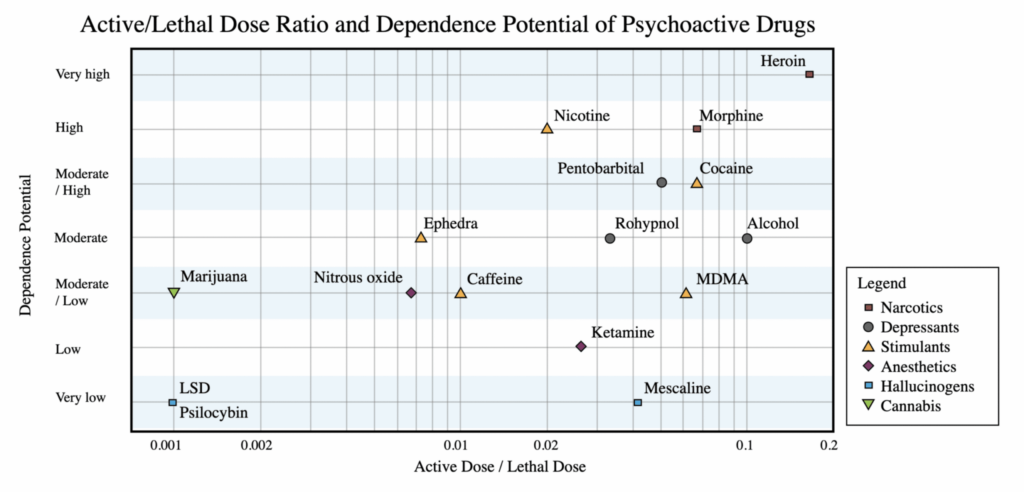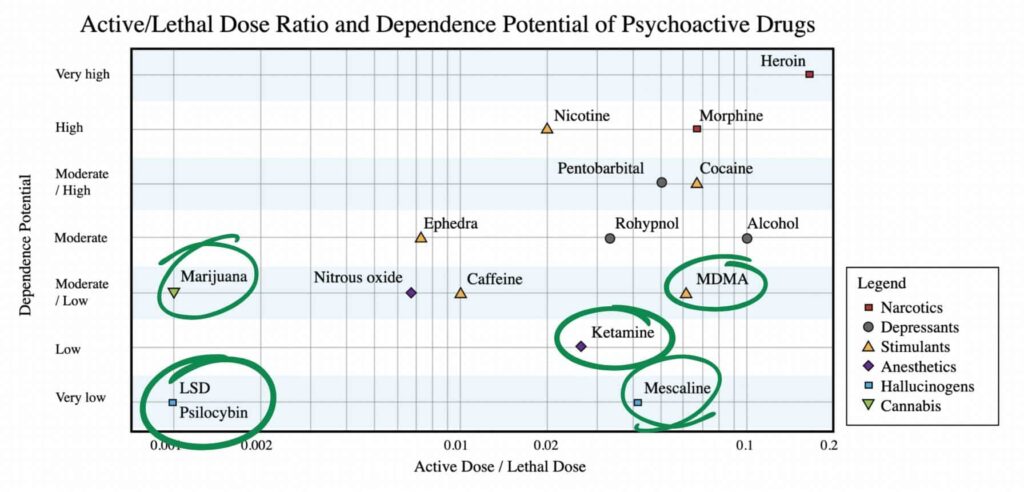If you haven’t heard about the psychedelic renaissance sweeping the globe over the past few years, let this be your wake-up call. Psychedelic medicines, from mushrooms to MDMA, have begun to gain more traction in clinical settings through the treatment of PTSD, reduction of anxiety, and quitting of addictions, including (and especially) smoking.
With the rising popularity of these substances, more opportunities are arising for “normal” people with no prior experience with these substances to get access to them (such as through microdosing) and experience a psychedelic journey of their very own.
I’ve had a lot of conversations with people like this, and reactions range from strong motivation to full-on fear. Fear of what they may find on the other side, sure, but also fear of whether taking these substances is actually physically safe for their bodies.
Straight answer: are psychedelics safe?
The short answer: yes, and you’d be surprised at exactly how safe they are.
I’ve spent the last year collecting research around the safety of psychedelics, specifically MDMA, psilocybin (the active ingredient in magic mushrooms), DMT, LSD, and Ketamine.
One of the most valuable pieces of research I’ve found came from Robert S Gable at Claremont Graduate University in California. In 2004, he was studying the toxicity of twenty popular abused substances that are widely distributed in Europe and North America. These substances ranged from caffeine to heroin.
The graph of Gable’s research compares the two most important factors when determining the safety of a highly-abused substance: addictiveness (vertical axis) and lethality (horizontal axis). The more you move up and to the right, the more dangerous the substance is.

You may recognize some of the substances in the graph of Gable’s research above. Remember—these aren’t all illegal drugs—they are commonly abused substances. Caffeine is widely available at your local supermarket and nicotine, alcohol, and cannabis are almost all readily available depending on what state you live in.
So this isn’t a question of which illegal drugs are safest—it’s a question of which substances we consume in general are safest. This study levels the playing field and removes politics and taboo from the analysis. You probably don’t regularly use heroine, but there’s a good chance that you’ve had an alcoholic or caffeinated drink in the last 24 hours. These are chemicals that permeate our everyday lives, and they have more in common than you may expect.
If you take a look at the data Gable collected around those twenty substances, you’ll notice a pattern: all of the psychedelic substances are skewed to the bottom of the graph (low dependence potential), and many of them are skewed toward the left (low lethality). I’ve highlighted psychedelic substances (both classic and non-classic) in green. Also note that the horizontal axis is scaled logarithmically, which means each step you take to the right, the difference in lethality is multiplied by a factor of ten.

Gable’s research shows us that psychedelics, across the board, have a lower dependency potential than all other commonly-abused substances, other than nitrous oxide. This includes alcohol, which has the second-highest level of lethality of the twenty recorded substances, falling short only of heroin.
The data also shows us that all six psychedelics in the study have a Moderate/Low level of lethality. Lethality is measured by dividing an active dose by a lethal dose, which means that a lethality of 1.0 would mean that one dose can kill you. Alcohol, again, is a loser here. It has the second-highest level of lethality of all twenty substances, beating cocaine and morphine and falling short only of heroin.
To date, there have been no recorded deaths due to overdose of a classic psychedelic (such as psilocybin or LSD). The data shows us that you’re safer tripping on LSD or mushrooms than you are drinking a cup of coffee. The same can’t be said about MDMA or Ketamine, which are both artificially created and have a slightly higher lethality and potential for abuse, but again, they fall short of alcohol, the lethality and addictiveness of which we have all seemed to accept. (Cue the lecture on double standards and the war on drugs)
Make room for psychedelics
There are a lot of people who have cut out alcohol from their diets entirely in preference of psychedelics. When you begin journeying with psychedelic substances, you’re actually exercising your brain in many ways (rather than poisoning it). Of course, this depends on which psychedelic you use and how much you take, but the fact remains the same: they are all safer than the bottles of wine, liquor, and beer that fill our cabinets.
Organizations such as MAPS (Multidisciplinary Association for Psychedelic Studies) and Johns Hopkins’ Center for Psychedelic and Consciousness Research are making huge progress in building valuable research, establishing solid arguments for the legalization of psychedelics, and informing the public of psychedelics’ potential for healing and transformation.
I encourage you to follow their research and keep tabs on this blog for more updates in the world of psychedelic news. There is more to come!


